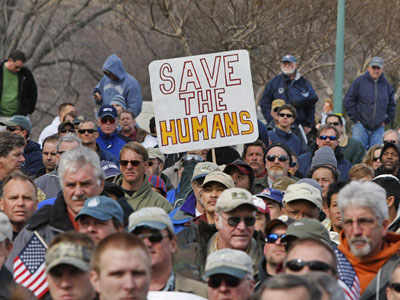Culled out
Obama administration will accept no more public input for federal fishery strategy
By Robert Montgomery
ESPNOutdoors.com
The Obama administration will accept no more public input for a federal strategy that could prohibit U.S. citizens from fishing the nation’s oceans, coastal areas, Great Lakes, and even inland waters.
This announcement comes at the time when the situation supposedly still is “fluid” and the Interagency Ocean Policy Task Force still hasn’t issued its final report on zoning uses of these waters.
That’s a disappointment, but not really a surprise for fishing industry insiders who have negotiated for months with officials at the Council on Environmental Quality and bureaucrats on the task force. These angling advocates have come to suspect that public input into the process was a charade from the beginning.
“When the World Wildlife Fund (WWF) and International Fund for Animal Welfare (IFAW) completed their successful campaign to convince the Ontario government to end one of the best scientifically managed big game hunts in North America (spring bear), the results of their agenda had severe economic impacts on small family businesses and the tourism economy of communities across northern and central Ontario,” said Phil Morlock, director of environmental affairs for Shimano.
“Now we see NOAA (National Oceanic and Atmospheric Administration) and the administration planning the future of recreational fishing access in America based on a similar agenda of these same groups and other Big Green anti-use organizations, through an Executive Order by the President. The current U.S. direction with fishing is a direct parallel to what happened in Canada with hunting: The negative economic impacts on hard working American families and small businesses are being ignored.
“In spite of what we hear daily in the press about the President’s concern for jobs and the economy and contrary to what he stated in the June order creating this process, we have seen no evidence from NOAA or the task force that recreational fishing and related jobs are receiving any priority.”
Consequently, unless anglers speak up and convince their Congressional representatives to stop this bureaucratic freight train, it appears that the task force will issue a final report for “marine spatial planning” by late March, with President Barack Obama then issuing an Executive Order to implement its recommendations — whatever they may be.
Led by NOAA’s Jane Lubchenco, the task force has shown no overt dislike of recreational angling, but its indifference to the economic, social and biological value of the sport has been deafening.
Additionally, Lubchenco and others in the administration have close ties to environmental groups who would like nothing better than to ban recreational angling. And evidence suggests that these organizations have been the engine behind the task force since before Obama issued a memo creating it last June.
AP/Luis M. AlvarezOne sign at the rally of recreational and commercial fishermen summed up the feelings.
As ESPN previously reported, WWF, Greenpeace, Defenders of Wildlife, Pew Environment Group and others produced a document entitled “Transition Green” shortly after Obama was elected in 2008. What has happened since suggests that the task force has been in lockstep with that position paper.
Then in late summer, just after he created the task force, these groups produced “Recommendations for the Adoption and Implementation of an Oceans, Coasts, and Great Lakes National Policy.” This document makes repeated references to “overfishing,” but doesn’t once reference recreational angling, its importance, and its benefits, both to participants and the resource.
Additionally, some of these same organizations have revealed their anti-fishing bias by playing fast and loose with “facts,” in attempts to ban tackle containing lead in the United States and Canada.
That same tunnel vision, in which recreational angling and commercial fishing are indiscriminately lumped together as harmful to the resource, has persisted with the task force, despite protests by the angling industry.
As more evidence of collusion, the green groups began clamoring for an Executive Order to implement the task force’s recommendations even before the public comment period ended in February. Fishing advocates had no idea that this was coming.
Perhaps not so coincidentally, the New York Times reported on Feb. 12 that “President Obama and his team are preparing an array of actions using his executive power to advance energy, environmental, fiscal and other domestic policy priorities.”
Morlock fears that “what we’re seeing coming at us is an attempted dismantling of the science-based fish and wildlife model that has served us so well. There’s no basis in science for the agendas of these groups who are trying to push the public out of being able to fish and recreate.
“Conflicts (user) are overstated and problems are manufactured. It’s all just an excuse to put us off the water.”
In the wake of the task force’s framework document, the Congressional Sportsmen’s Foundation (CSF) and its partners in the U.S. Recreational Fishing & Boating Coalition against voiced their concerns to the administration.
“Some of the potential policy implications of this interim framework have the potential to be a real threat to recreational anglers who not only contribute billions of dollars to the economy and millions of dollars in tax revenues to support fisheries conservation, but who are also the backbone of the American fish and wildlife conservation ethic,” said CSF President Jeff Crane.
Morlock, a member of the CSF board, added, “There are over one million jobs in America supported coast to coast by recreational fishing. The task force has not included any accountability requirements in their reports for evaluating or mitigating how the new policies they are drafting will impact the fishing industry or related economies.
“Given that the scope of this process appears to include a new set of policies for all coastal and inland waters of the United States, the omission of economic considerations is inexcusable.”
This is not the only access issue threatening the public’s right to fish, but it definitely is the most serious, according to Chris Horton, national conservation director for BASS.
“With what’s being created, the same principles could apply inland as apply to the oceans,” he said. “Under the guise of ‘marine spatial planning’ entire watersheds could be shut down, even 2,000 miles up a river drainage from the ocean.
“Every angler needs to be aware because if it’s not happening in your backyard today or tomorrow, it will be eventually.
“We have one of the largest voting blocks in the country and we need to use it. We must not sit idly by.”

